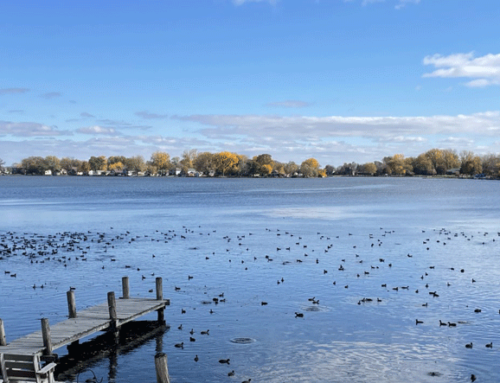Author: Ryan Koenigs, Winnebago Sturgeon Biologist
Featured photo: Michael Larson with the 140.6 pound, 78.9” lake sturgeon that he registered at Payne’s Point on February 12, 2017.
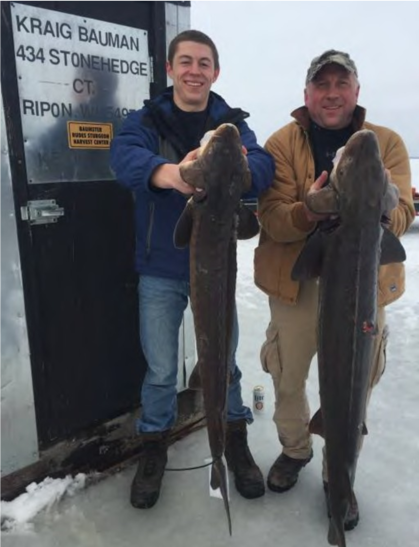
Father-son duo Kraig (right) and Marshall Bauman proudly display their sturgeon harvested during opening day of the 2017 Upriver Lakes spear fishery. This was Marshall’s first fish.
The 2017 sturgeon spearing season on the Winnebago System will primarily be remembered as a season heavily impacted by weather conditions. Ice conditions were favorable coming into the season’s opening weekend. However, temperatures in the upper 40s and low 50s quickly deteriorated ice conditions and caused most spearers to pull their shanties prior to the 2nd weekend of the season. In fact, effort was reduced to such a low level that the DNR decided to only operate 3 registration stations (2 on Lake Winnebago and 1 on the Upriver Lakes) starting on day 10 and did not staff any registration stations during the final weekend of the season.
Mild winter weather also negatively impacted water clarity during the 2017 sturgeon spearing season. Reliable reports from spearers and ice anglers indicated very clear water prior to an extended period of warm weather in mid-January. The warm temperatures didn’t impact ice conditions for opening weekend, but water clarity decreased substantially to an average of 9.5’ of visibility (range: 4-12’; Figure 1). Clearer water (10-12’ visibility) was present along the east and north shores of Lake Winnebago while the areas south and west were more turbid (4-10’ clarity). Regardless, water clarity was below the average 12’ threshold that usually is required to provide a large enough harvest to force an early season closure.
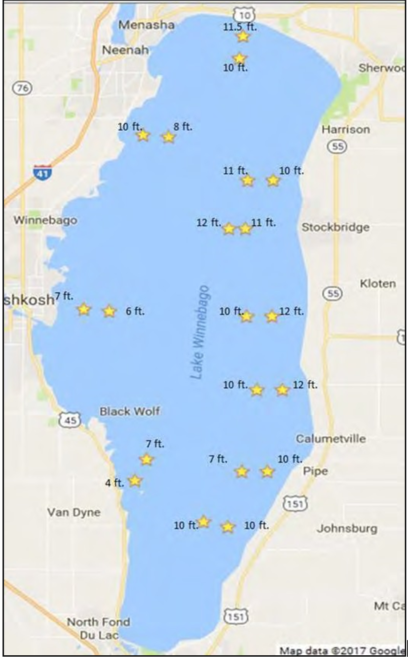
Figure 1. Water clarity observed on Lake Winnebago as of February 8, 2017.
The spear fishery on Lake Winnebago lasted the full 16 days with a total harvest of 552 fish, ranking 45th out of 77 seasons dating back to 1941. 2017 marks the 8th season to last the full 16 days since the harvest cap system was implemented in 1999 (19 seasons). Further, 7 of the past 12 seasons have now gone the full 16 days. The registration station at Stockbridge Harbor paced the way with 161 fish registered followed by Payne’s Point (109 fish), Calumet Harbor (81 fish), and Quinney (75 fish) (Table 1).
The 2017 sturgeon spearing season on the Upriver Lakes was the first to last the full 16 days since implementation of the lottery fishery in 2007. The average season length during that time has been 6.2 days (range: 2-16 days) with an average harvest of 297 fish (range: 242-313). The 2017 Upriver Lakes spearing season included the harvest of 295 fish, thus very similar to the average harvest. The sturgeon registration station at Critter’s Wolf River Sports in Winneconne registered 193 fish and was the busiest station on the Upriver Lakes. The registration stations at Indian Point and Boom Bay registered 58 and 44 fish respectively.
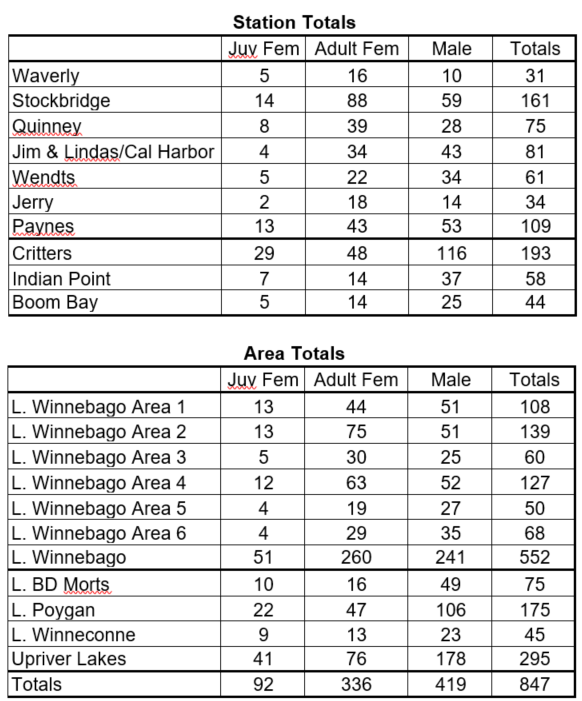
Table 1. Number of juvenile female, adult female, male, and total lake sturgeon registered at the 7 registration stations on Lake Winnebago and 3 registration stations on the Upriver Lakes during the 2017 spear fishery on the Winnebago System. Also displayed are the number of lake sturgeon harvested from each of the 6 areas of Lake Winnebago and each Upriver Lake during the season.

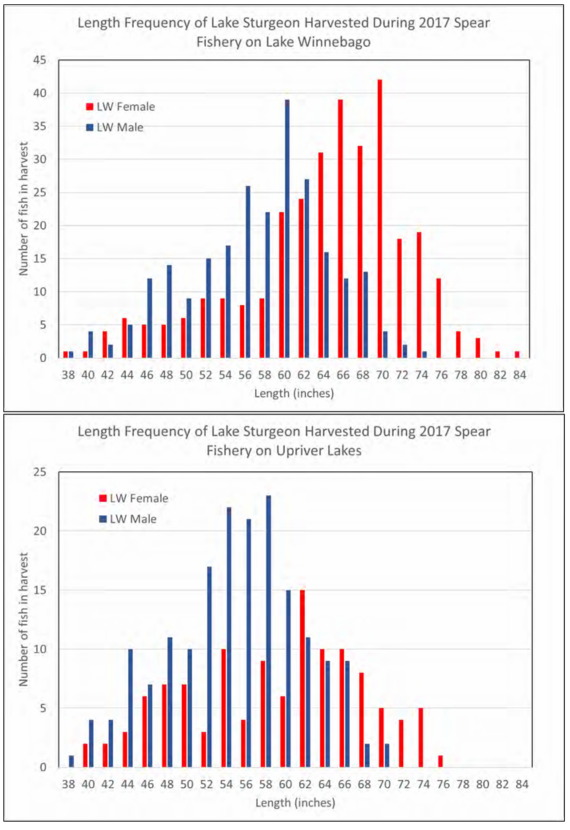
Figure 2. Length frequency of male and female lake sturgeon harvested during the 2017 spear fishery held on Lake Winnebago (top) and the Upriver Lakes (bottom).
The 2017 harvest from Lake Winnebago consisted mostly of 60-69.9” females (54.0% of the female harvest) and 52-63.9” males (61.0% of the male harvest) (Figure 2). Fish >70” are typically near the 100-pound mark and 18.6% of the females and 1.2% of the males from the 2017 harvest on Lake Winnebago were longer than 70”. As expected, the size distribution observed in the Upriver Lakes harvest was skewed towards smaller fish relative to the harvest on Lake Winnebago (Figure 2). For example, 23.1% of the female harvest and 26.4% of the male harvest on the Upriver lakes were fish <50”, compared to just 9.0% of the females and 19.5% of the males harvested from Lake Winnebago. Past telemetry data indicate that the Upriver Lakes act as a nursery area for juvenile sturgeon, thus the difference between the two different fisheries.
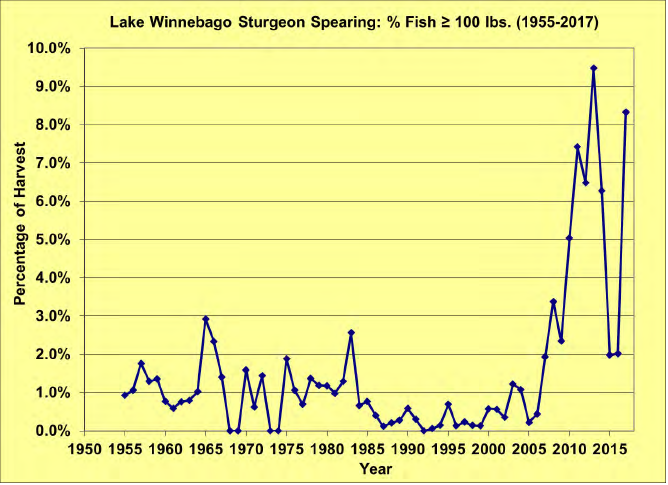
Figure 3. Percent of the lake sturgeon harvest from Lake Winnebago that was comprised of fish 100 pounds or larger (1955-2017).
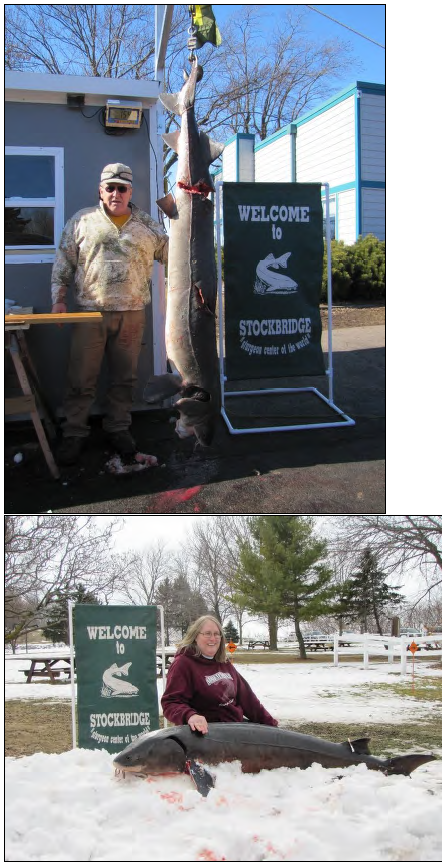
Figure 4. Gerald Petersen (top) and Sandra Schumucher (bottom) proudly display the lake sturgeon they harvested during the 2017 sturgeon spearing season on Lake Winnebago. Gerald’s fish (154.9 pound, 83.4”) was the largest fish harvested during the 2017 season followed by Sandra’s fish (154.7pounds, 78.5”) as the 2nd largest.
Highlighting the 100+ pound fish in the harvest were two fish that weighed 150 pounds or larger and 9 fish at 140 pounds or larger. Gerald Petersen registered the largest fish of the season (154.9 pounds; 83.4”) with Sandra Schumacher registering the 2nd largest fish (154.7 pounds; 78.5”) (Figure 4). Both fish are impressive in their own right, but Gerald’s fish was one of the longest fish harvested on record.
Coming into the season, DNR staff anticipated seeing a strong contribution of large fish within the harvest. The sturgeon spearing record book has all but been rewritten since the 2004 season (Figure 5), mostly during the 2010-2013 seasons, and the handling of 75+” fish has become common place during spring sturgeon spawning stock assessments over the last decade. Additionally, a strong gizzard shad hatch in 2016 and a moderate abundance of Chironomid (lake fly) larvae, provided a forage base anticipated to increase fish condition. Our prognosis was accurate as the 2017 season on Lake Winnebago included the 2nd highest percentage of 100+ pound fish during seasons dating back to 1955 (Figure 3).
Winnebago (13.5%) and the Upriver Lakes (17.1%), while only stomachs collected from Lake A total of 87 lake sturgeon stomachs, 52 from Lake Winnebago and 35 from the Upriver Lakes, were sampled during the 2017 spearing season. Gizzard shad were observed in most of stomachs collected from both Lake Winnebago (71.2%) and the Upriver Lakes (82.9%) respectively (Figure 6). Chironomid larvae were also observed in sturgeon stomachs collected from both Lake Winnebago contained isopods (5.8%) and zebra mussels (3.8%). Quantitative diet data is available from the 1994, 2013-2016 on Lake Winnebago and 2013-2016 seasons on the Upriver Lakes (Figure 6). Diet data collected from Lake Winnebago during the 2017 harvest were most comparable to the 2013 and 2014 seasons. In general, there is less variation observed in diets from sturgeon harvested from the Upriver Lakes during the winter spear fishery. In fact, gizzard shad were the most prevalent forage item observed in sturgeon stomachs sampled from 4 out of five seasons, with 2015 being the exception.
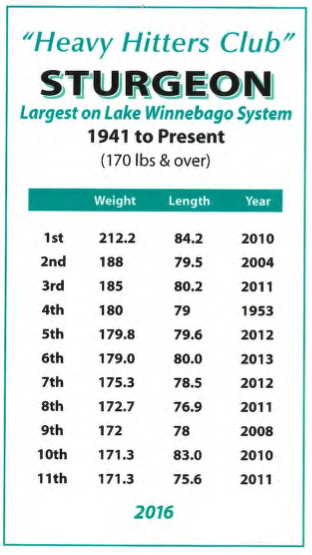
Figure 5. Heaviest lake sturgeon on record as harvested from Lake Winnebago and the Upriver Lakes.
The Oshkosh DNR fisheries crew is currently working with UW Stevens Point on a comprehensive study to evaluate various methods for assessing age and growth of lake sturgeon. Traditionally the leading ray of the pectoral fin ray has been collected, sectioned and read under a microscope to estimate fish age (photo inset) similar to the process of estimating the age of a tree. However, it is well documented that this method underestimates the age of older lake sturgeon. As part of the current study, we are evaluating alternative age estimation techniques including sectioned otoliths (ear bones), correction of errored pectoral fin ray age data, and application of mark- recapture data in growth models. The 2017 spearing season marked the first season of otolith collection for the project, thus we requested that successful spearers donate their sturgeon head. The response from spearers was very positive, as we removed otoliths from 473 fish. I have included some photos of the otolith removal process (Figure 7), but there will also be information about this project available in the future.
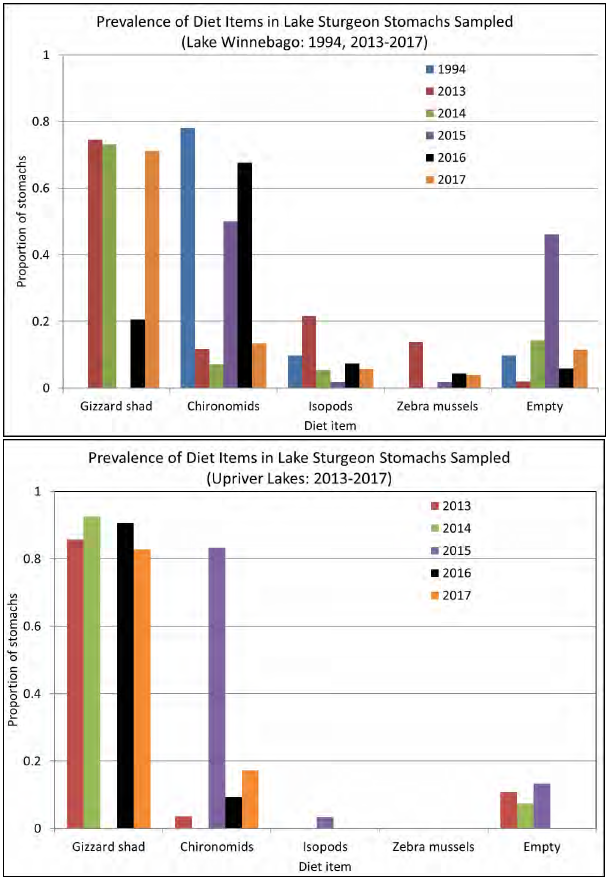
Figure 6. Proportion of various prey items observed in lake sturgeon stomachs sampled from Lake Winnebago (top) and Upriver Lakes (bottom) during the 1994, 2013-2017 spear harvests.
Reflecting on the 2017 sturgeon spearing season, I would classify the season as a success. Yes, there was a below average harvest on Lake Winnebago and we experienced the first full 16-day season on the Upriver Lakes. But when it comes to water clarity and ice conditions, Mother Nature is in the driver’s seat and some things are outside of our control. An extended stretch of mild weather in mid-January dealt a damaging blow to water clarity and another extended warm spell during the season quickly deteriorated ice conditions. Despite less than ideal, and ever changing, conditions, spearers were still able to harvest 847 lake sturgeon during the spearing season. This is the largest recreational harvest of lake sturgeon in the world and by quite a large margin. Additionally, spearers safely navigated the changing ice conditions to renew traditions associated with another season.
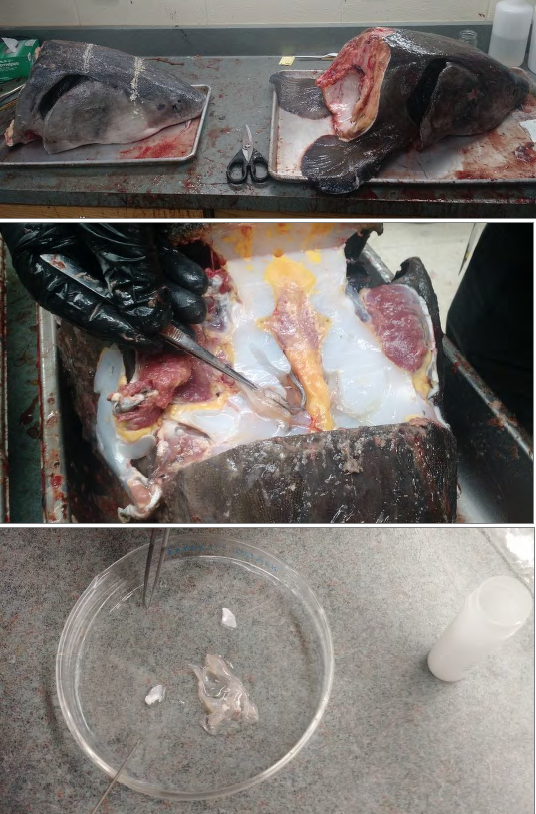
Figure 7. Photos of lake sturgeon otolith removal demonstrating the two transverse cuts across the skull plate (top), removal of the otolith succules from the auditory canals (middle), and removal of otoliths from the saccule (bottom).
The opening day shanty count of 5,074 shanties on Lake Winnebago is the 2nd highest on record, behind only 2009 (5,958 shanties), and to my knowledge there were no major safety incidents during the spearing season. That is really a testament to spearers for being able to monitor and read ice conditions. Lastly, the 2017 season included the harvest of some very large fish, including two fish weighing more than 150 pounds. Every fish harvested during a spearing season is a trophy, but harvesting one of these large fish is truly a once in a lifetime opportunity.
I would like to thank all the spearers for their continued interest in the sturgeon spear fishery on the Winnebago System. It’s the people and social aspects of sturgeon spearing that make this event so special. I look forward to making more memories during upcoming seasons, until then I will be waiting with anticipation for the next season to begin on Saturday February 10, 2018!
Ryan Koenigs
Winnebago Sturgeon Biologist
CLICK HERE to download a pdf version of the synopsis.



